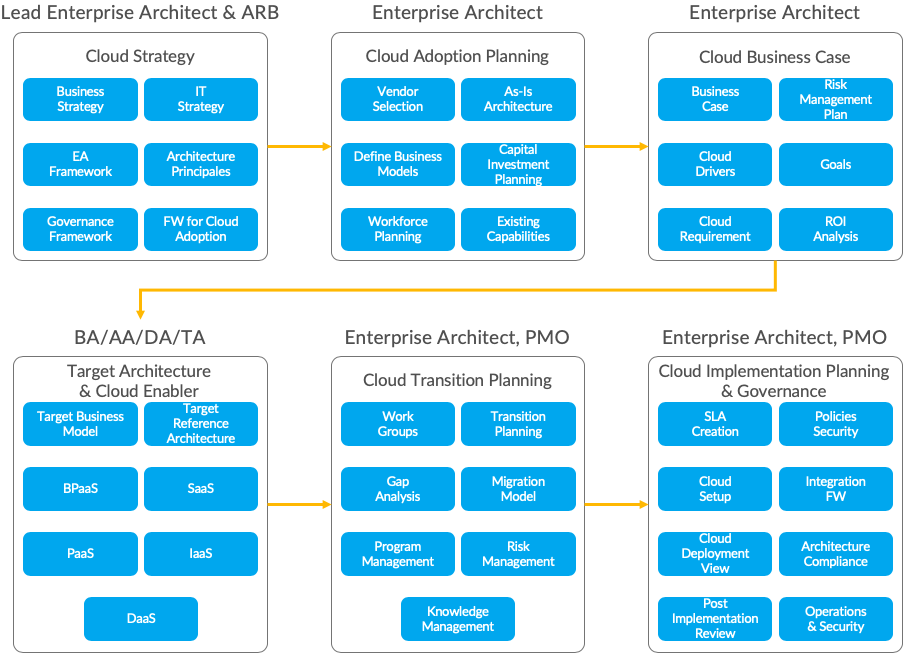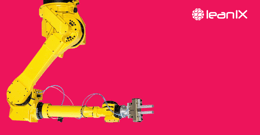Next generation enterprise trends and Cloud Adoption
Top business trends as a result of cloud adoption include:
- Expanding ecosystems of applications to stimulate market responsiveness.
- Shifting business models to become integrators of best-of-breed services.
- New regulatory requirements gained by a collaborative global economy and resulting from the need to address open markets.
- Leveraging digital proliferation to deliver more intelligent, predictive customer experience.
- Transformation and optimization across different process stacks: Sales, Front-office, Middle office and Back office.
Top technology trends as a result of cloud adoption include:
- Data center rationalizing (hybrid options to replace data centers).
- Movements of IT development and testing to cloud.
- Maximizing productivity with scalability and high availability. Top-tier functions are increasingly moving to private cloud and secondary ones to public cloud.
- Emergence of cloud service brokerages—a shift to hybrid models.
- Elevating traditional services by offering new digitized products like cloud-based storage for customer files.
- Fusing IaaS with PaaS.
Cloud Adoption framework based on enterprise architecture
Enterprise Architecture, as a discipline focused on connecting an enterprise’s current reality to one desired in the future, can contribute to enterprises when it comes to managing cloud-based systems. A primary benefit related to EA and cloud includes seeing how and where newer, highly disparate cloud systems might fit with legacy versions.
A well-run EA program can streamline cloud transformations using best practices developed from IT strategy, business policy, organizational planning, and stakeholder decision-making. However, in order to integrate EA with the cloud computing services of an enterprise, a framework needs to be established whereby EAs manage all stages of an enterprise’s cloud adoption.
The following is an EA framework for migrating to and adopting cloud services:
![A Business Capability Cost Report, set by an "Unreasonable Technical Fit", in LeanIX.]()
Image 1: Cloud Adoption Framework based on Enterprise Architecture
Cloud Adoption strategy
This is the first step in cloud adoption. At this stage, the tasks typically involve collecting all artifacts and related information about an enterprise’s current “as-is” state and all formal procedures for the daily operations of existing EA. One should use this stage to analyze the needs, requirements, and trends in each of the business units of an organization while validating the potential weaknesses, strengths, opportunities, and threats in the adoption of a cloud.
It is necessary to develop an understanding at this stage of the business’s overall strategy and its organizational goals.
Further, a Cloud Adoption Strategy stage is the time to outline all information about the expected goals of target architecture, the identities of relevant stakeholders, the complexity of architectural visions, and the various approvals required when initiating change.
Cloud Adoption planning
Use this stage to understand the as-is architecture and existing EA across the organization. Doing so involves defining business models according to operational roles and activities, and the gathering of operational costs. It is a time to align requirements and motivations for cloud migration with EA models.
Cloud Adoption Planning is about envisioning the opportunities available for when cloud computing is actually implemented, describing these possible benefits in clear detail, and then evaluating it all to the concerns of relevant stakeholders and the capabilities of potential vendors. Following this awareness, an appropriate cloud environment for applications—as based on cost efficiency and performance—can be chosen.
Cloud business case
EA can broaden a business case for cloud adoption by providing an understanding of overarching capabilities needed to support the implementation and ongoing maintenance of the new platform. Such methods might include delineating the business case and ROI inputs to estimate the required budget, assessing the ease-of-adoption in technical terms, and then selecting the cloud provider.
The following activities should occur in this stage:
- Identifying all viable business alternatives associated to any proposed cloud technology in order to hold a holistic overview of upcoming opportunities.
- Identifying and structuring all benefits to a business for cloud transformation as based on explicitly detailed degrees of impact.
- Calculating the budget required and the ROI expected during EA changes.
- Estimating migration timeframes.
- Analysis of the present risks and an ongoing approach for identifying and mitigating future risks.
Target architecture & cloud enabler
The use of new cloud services to augment target Business Architecture, Information System Architecture, and Technology Architecture is detailed at this stage. Spanning also Information Architecture (physical and logical data models), Application Architecture (functional components, interrelationship between systems), and Technology Architecture (hardware, software, and communication infrastructure).
This stage should be when all information is identified on target architecture that can be used to accommodate cloud transitions and help detail business requirements. The impact of architectural changes on business models should also be defined at this stage.
Cloud transition planning
Cloud Transition Planning is when all technical gaps between target and baseline EA must be recognized and then logically described. It is an analysis for identifying the shortfalls between actual and potential performance and then using this analysis to create a change management plan.
The creation of a detailed plan for the actual implementation and migration from the existing to the target architecture occurs during this phase.
Cloud Transition Planning typically consists of the following activities:
- Laying out a cloud migration plan strategy that lists the required processes, tools, and business chargeback models for
- migrating existing business applications to the cloud,
- placement decisions for new applications.
- Assessing all enterprise applications to determine where business function “bundle” descriptions fall into, and the relationships between applications and bundles. Such information will then be used to recommend a suitable market-based cloud product of relevant business value.
Given that cloud providers make such implementation arrangements, it is wise to review the many desired requirements of target architecture to obtain from vendors a worthwhile service lifecycle arrangement (SLA), a properly configured network setup, and a clear understanding of how it can be integrated to operate with other clouds.
Cloud implementation planning & governance
At this stage, final confirmation is received on the scope and priorities of cloud migrations and deployment. SLAs are established, as are policies and security standards, and the allocation of authority and responsibility is distributed. Cloud Implementation Planning and Governance cover the strategy-to-execution phases of a cloud adoption strategy.
Identification of all deployment resources and skills is required during this stage. EA compliance reviews are performed here, and the implementation of business and IT operations plus post-implementation reviews occur.
Other activities performed during this stage include:
- Evaluating business-level policies.
- Understanding differences in service and deployment models.
- Identifying critical performance objectives.
- Evaluating security and privacy requirements.
- Identifying service management requirements.
- Preparing for service failure management.
- Understanding recovery plans.
- Establishing effective management processes.
- Creating the exit process.
Any and all results from these many monitoring activities must be documented and shared in a post-implementation review to offer input for further improvements in future projects. Of note, long-standing providers of enterprise architecture management software have extended their offerings with dedicated products for end-to-end cloud implementation and governance planning.
Conclusion
Cloud technology is playing a major role in the transformation of modern enterprises. Though it is not a complete solution to the problems of on-premise solutions, transferring certain enterprise applications and processes to the cloud can certainly minimize many of the organizational hurdles once simplified only with good EA management.
Furthermore, as cloud technology matures, the core ways in which businesses operate will continue to change. It is thus necessary for EA to mitigate the speeds of disruption at a level carefully aligned to an enterprise’s capacity for change.
EA enables organizations to undergo digital transformation to implement new cloud systems with considerably fewer complications, and an EA Framework for Cloud Adoption like the one presented is an approach that can easily be followed to reduce development times, improve scalability, expand storage capacities, improve the reliability of services, and fortify security.
To repeat, cloud computing can assist enterprises in:
- Moving to an agile operating model and removing supposedly “indispensable” technology.
- Attracting top digital talent from across industries and providing them a toolbox of the best technologies available.
- Transforming architecture to scale capabilities and enable dynamic API-based interactions.
- Bringing cloud-native capabilities to applications and upgrading them to deliver real-time metrics and actionable data.
- Creating digital capabilities for accelerating revenue by using an agile and opex model of cloud.
It all goes to show that no matter what tools enterprises choose to use, the core problem is not always with the technology. It is in defining the relationships between different components—from Business to IT.
And that is where EA comes in.
References
- https://www.idc.com/promo/thirdplatform/RESOURCES/ATTACHMENTS/IDCFutureScapeExecSummary-Cloud.pdf
- https://www.gartner.com/en/newsroom/press-releases/2018-09-12-gartner-forecasts-worldwide-public-cloud-revenue-to-grow-17-percent-in-2019
Editor´s note
This content was contributed by Dr. Gopala Krishna Behara, senior enterprise architect in the GEA Practice division of Wipro. He has over 22 years of IT experience and can be reached at gopalkrishna.behra@wipro.com. The author would like to thank Hari Kishan Burle and Raju Alluri, Wipro Technologies’ GEA Practice for providing support and their knowledge in the writing of this article.
Disclaimer
All views of the content is the author’s and doesn’t reflect the opinion of WiPro.




